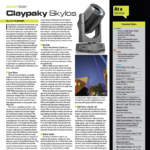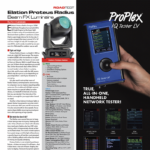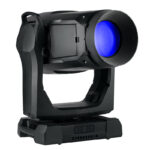Creative LED products are becoming more and more popular, especially in the installation and touring markets. Designers are looking for unique ways to design with light and video while also bringing to life their artistic visions. However, in order to be able to design freely with LEDs, products have to be easily manipulated and flexible in order to be shaped into virtually any design; this means that LEDs have to be available in configurations other than linear strips or matrices like those found in LED video panels. The VC-Dot series from Martin meets these demands and excels in ways other LED strings stop short.
LED “Dots” and Cables
First of all, the VC-Dot series is a range of products that feature LED ‘dots’ connected via flexible ribbon cables. While the VC-Dot 1 is comprised of a single LED, the VC-Dot 4 contains 4 LEDs, and the VC-Dot 9 contains 9 LEDs. These dots can be spaced as closely together as 50mm and up to 2000mm, depending on the needs of the project.
Hardware Specs
The VC-Dot series even has options for the color of the LEDs. You can choose from RGB color mixing or single color versions including cool, medium, or warm white. Have you ever tried using LEDs and noticed that the whites don’t match? No problem when you use these LEDs: I tested the RGB versions of each, and I was easily able to calibrate any of the pixels that needed calibration via the P3 controller. One additional note about the LEDs: if you are looking for a more traditional grid layout of LEDs, these are the same LEDs used in the VC-Grid and VC-Strip as well.
The dots can be used with or without the optional “Diffuser Dome”; it can be used to eliminate the direct view of the LED while softening and widening the output from the LED. I personally prefer them with the dome, but if you were planning to embed them into a flat surface, you could remove the domes and then just use opaque Plexiglas or something similar to soften the output.
Multiple dots can be strung together, up to 100 for the VC-Dot 1, 64 for the VC-Dot 4, and 36 for the VC-Dot 9. This limitation on number of LEDs per string simply has to do with the power consumption for each dot. Each dot can peak at around 1.2W in full white, so on strings of VC-Dot 9, this can add up quickly. However, Martin also offers the VC-Feeder to both refresh and provide steady power for installations where the P3 is hidden in a remote closet away from the dots.
Another nice feature of the dot is the housing. The housing is rated at IP65, which means they can be used outdoors as well as indoors. I can only imagine how they could be used in Las Vegas on the strip!
Playback
The VC-Dot series is easily controlled via Martin’s P3-100 System Controller and/or DMX512. To map video onto the dots, you simply connect a video signal to the P3. In the P3 user interface you create a map of how the dots are laid out. Then, the P3 does all the work in mapping the incoming video signal onto the dots. Dots are connected to the P3 via Martin’s hybrid cables, providing both power and data. And if you want to control the dots via DMX instead, it’s also easy to do. You don’t need to use the P3; simply connect directly to the VC-Feeder and then you can program them using RGB channels from your lighting console. Having both options makes using the VC-Dots very effective for a variety of applications.
When I received the demo kit from Martin each of the three types of products were already affixed to crossbars mounted in wooden square frames measuring two feet per side. This made connecting the Dots and powering them very easy. The demo kit also included the P3-100 as well as the necessary cables. All I had to provide was the video signal, and I used a media server.
What I noticed about the VC-Dot demo pieces was how important it is to make sure your alignment and spacing is between dots, especially in a matrix or grid-type arrangement. To set up individual strings for a new project will require time spent on measuring the spacing between each dot and getting it just right so that your video image looks correct. On a large scale, this would likely require many hours of measuring the ribbon cables between the dots, and affixing them to the dots at the correct spacing. Might be a little tedious for a one-off, but not out of the question for a tour or long-running application.
Design Flexibility; IP Rating
The VC-Dot series shows promise as an excellent choice for scenic designs, architectural designs (both indoors and out) and commercial installations, and also for artistic creations in museums and other venues. These dots are very flexible, bright and easy to set up. I think for all of these reasons, the VC-Dot series would also make an excellent choice for any application where LEDs are needed in soft goods as well. The Martin website features a few images from a recent European tour where the designer created an LED curtain in non-traditional dimensions. This is the type of flexibility that VC-Dots afford.
Flexibility and outdoor weather rating make this range of products well suited as well for incorporating video into stage designs, outdoor structures, or for many other types of applications where you might want to have video without using LED panels or projection. VC-Dots can be used in so many different ways; you are only limited by your imagination.
I also found the P3-100 system controller to be one of the easiest processors for LED control that I’ve used so far. Its user interface is well-thought-out and simple to grasp. Its pixel mapping control is efficient; it doesn’t require a lot of setup.
The P3 video mapping area has a built in library of Martin LED products, and once connected via an Ethernet cable, the P3 auto-detects the networked products and allows you to configure them into the desired layout. It provides built in test patterns as well as a straight-forward video signal input window that shows you exactly what you should be seeing on the LEDs. This concise and user-friendly package makes working with these LEDs relatively painless. And this processor is also the same processor for Martin’s other LED products, making the learning curve that much simpler.
Potential users should note that the unlimited flexibility and lack of existing hanging frames or structures also means that you will need to provide your own structure in order to hang the dots. This isn’t a negative, just more of an observation. The VC-Dot series was not designed to be cookie cutter; instead, using these dots gives you the freedom to build what ever shape you want and put LEDs on it. So just remember to plan out the entire project including hanging structures and hardware when you’re thinking about using the VC-Dots in your design.
At a Glance
Bright and Flexible
The VC-Dot series is particularly well-suited to scenic and architectural designs that take advantage of the product’s flexibility, such as an LED curtain taking the form of unusual, creative shapes.
Martin VC-Dot Series
Pros: Flexible, rated for outdoor use, creative design alternative to rigid LED panels and projection. P3-100 system controller is easy to use.
Cons: You’ll need to think through and design or create hanging frames and structures; definitely not a cookie-cutter product.
MSRP*:
VC-Dot 1 (100mm string of 100 RGB dots): $1,750
VC-Dot 4 (200mm string of 64 RGB dots): $1,950
VC-Dot 9 (400mm string of 36 RGB dots): $1,950
VC-Grid 8×8: (200 x 200 mm square, 64 RGB dots): $205
VC-Strip 25 (399x20x18mm strip, 16 RGB dots): $110
P3-100 System Controller: $13,995
* Since this product is flexible in configuration, these prices are just a sample of pricing available. Contact your Martin representative for more information.
More Info: martin.com



